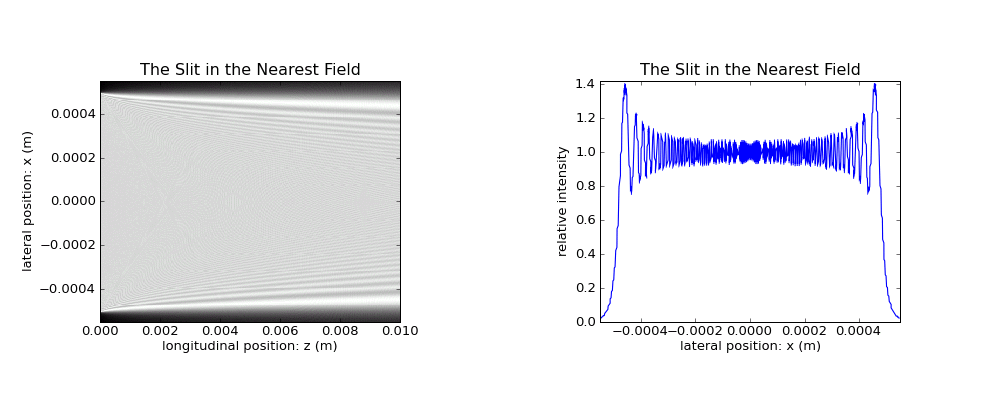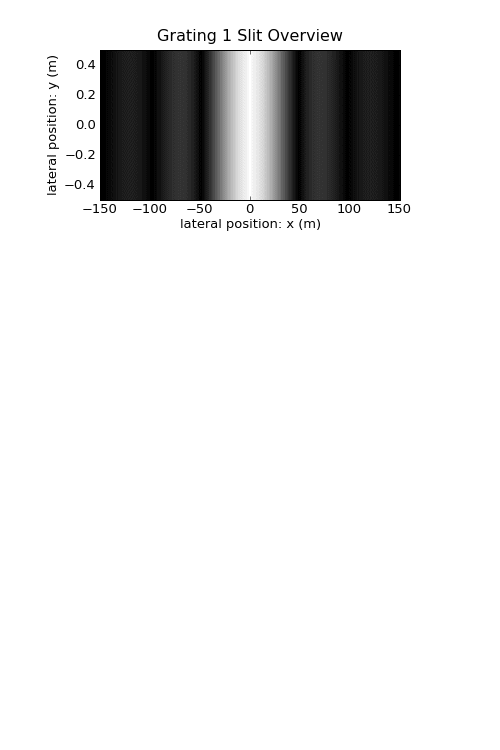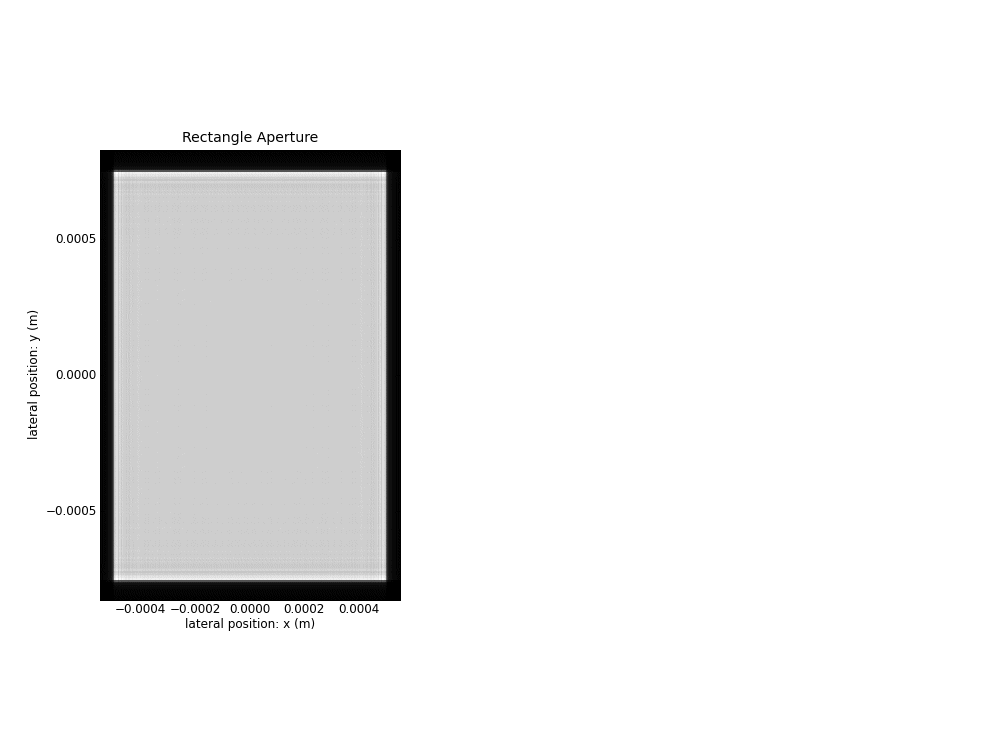|
Theoretical Physics
Multislit
Gauss Beam
|
Examples |
|
| |
| The Slit | Der Spalt |

In the nearest and middle field, the transversal x scale stays invariant, and the longitudinal z displays more and more space. The diagram to the right displays in that pictures the profile through the center z position. Partly there are also z profiles instead of x profiles shown.
In the far field, the x and z scales are choosen such that the diffraction pattern is clearly visible. On the right, first the z profile is shown, then the x profile, and finally the x profile is shown also in the 2D diagram.
Single Frames
Im nahesten und mitteleren Feld bleibt die x-Skala invariant und die longitudinale z-Skala umfasst mehr und mehr Raum. Das Diagramm auf der rechten Seite zeigt in diesen Bildern einen Schnitt durch die zentrale z-Position. Teilweise sind auch z-Profile statt x-Profile gezeigt.
Im Fernfeld werden die x- und z-Skalen so gewählt, daß das Beugungsbild klar erkennbar ist. Auf der rechten Seite wird zuerst der z-Schnitt gezeigt, dann der x-Schnitt, und schließlich ist das x-Profil auch im 2D-Diagramm gezeigt.
Einzelne Frames

The first picture is to scale, i.e., x and z have the same scaling factor. The picture is thus a magnification of the real observable pattern.
For the second and the following pictures, the scale is changed, such that the pattern becomes best visible. x and z have no longer have the same scaling factor. But for all pictures from the second on, this scale itself stays invariant, only the longitudinal z position is shifted to higher z on the optical axis.
One can discern, how the pattern stays in principle the same, and how it scales with growing z.
Single Frames
Das erste Bild ist richtig skaliert, d.h. x und z besitzen denselben Sklierungsfactor. Das Bild ist damit eine Vergrößerung des tatsächlichen beobachtbaren Bildes.
Vom zweiten Bild an ist die Skalierung geändert, so daß das Muster am besten zur Geltung kommt. x und z sind nicht länger mit demselben Faktor skaliert. Aber für alle Bilder vom zweiten Bild an bleibt die Skalierung selbst die gleiche, nur die longitudinale z-Position wird zu höheren z auf der optischen Achse verschoben.
Man kann erkennen, wie das Muster im Prinzip dasselbe bleibt, und wie es mit wachsendem z skaliert.
Einzelne Frames

The profile on the right at center z position shows nicely the noticable complex structure of the diffraction pattern.
Single Frame
Der Schnitt auf der rechten Seite an zentraler z-Position zeigt schön die bemerkenswerte Komplexität des Beugungsmusters.
Einzelner Frame

The slit number increases from one to nine. Top the intensity picture, middle and bottom 1D diagrams of the intensity.
The number of intermediate lobes between the main lobes increases with the slit number and is always equal to the slit number diminished by two. As the finite grating is the product of the infinite grating with a single broad slit, the Fraunhofer diffraction pattern is the convolution of the delta comb (multiplied by the form factor) with the sinc pattern of this single broad slit. With growing slit number the approximation of the delta comb, multiplied by the form factor, can be seen.
The first two pictures are overviews of the diffraction pattern of one or two slits. From then on the lateral x scale changes to fit only the central lobe of the form factor pattern.
Between the first and second picture and in the following sequence the intensity scale of the middle diagram never changes. The scale of the lower diagram in contrast is always fitting the whole profile.
The width of the broad mask slit is uncertain to one slit distance. From the fourier space point of view, it is remarkable, that for all possible choices of the slit mask the convolution integral of this different sinc functions with the delta comb is always the same.
Single Frames
Die Spaltanzahl steigt von eins zu neun. Oben das Intensitätsbild, in der Mitte und unten 1D-Diagramme der Intensität.
Die Anzahl der intermediären Lappen vergrößert sich mit der Spaltzahl und ist immer gleich der um Zwei verminderten Spaltanzahl. In der Darstellung des endlichen Gitters als das Produkt aus unendlichem Gitter und einem breiten Spalt ist das Fraunhofer-Beugungsbild die Faltung aus Delta-Kamm (multipliziert mit dem Formfaktor) und der sinc-Function dieses einfachen breiten Spaltes. Mit steigender Spaltanzahl kann die Annäherung an den Delta-Kamm, multipliziert mit dem Formfaktor, deutlich erkannt werden.
Die ersten beiden Bilder sind Überblicke über das Beugungsbild von einem oder zwei Spalten. Von da an ändert sich die Skalierung der lateralen x-Achse, um bloß auf den zentralen Lappen des Formfaktorbildes zu passen.
Zwischen dem ersten und zweiten Bild und in der darauffolgenden Sequenz ändert sich die Intensitäts-Skalierung des mittleren Diagramms nie. Die Skalierung des unteren Diagramms passt dagegen immer auf das gesamte Profil.
Die Breite der Spaltmaske ist unbestimmt bis auf eine Spaltdistanz. Aus dem Standpunkt im Fourierraum heraus ist es bemerkenswert, daß für jede mögliche Wahl der Spaltmaske das Faltungsintegral dieser verschiedenen sinc-Funktionen mit dem Delta-Kamm immer dasselbe Resultat liefert.
Einzelne Frames

For the first seven pictures, the transversal scale is invariable, only the longitudinal position is increased. From the seventh to the eighth picture the transversal scale range is increased, to show more of the angular diffraction pattern, while that, the longitudinal position is unchanged. In the picture series starting with the eighth picture, both longitudinal and transversal scale are increased simultaneously, keeping now the aspect ratio constant. Therefore the pictures show then an angular picture, with same angles at same position in every picture.
The diagram on the right side shows always a profile through the x axis of the 2D diagram at y = 0. With increasing depth the pronounciation of the lobes increases, until it reaches the final complete separation in quasi-infinity. Furthermore, notice the high intensity at the edges of the aperture in the nearest field. This effect is known to be typical for diffraction apertures, when one watches at the aperture their edges seem to be brightly glaring.
Single Frames
Für die ersten sieben Bilder bleibt die transversale Skala invariant, es wird lediglich die longitudinale Position erhöht. Vom siebten zum achten Bild wird die transversale Skala erhöht, um einen größeren Winkel des Beugungsmusters abzudecken, währenddessen bleibt die longitudinale Position ungeändert. In der Bilderserie vom achten Bild an wird sowohl die longitudinale als auch die transversale Skala vergrößert, während ihr Verhältnis nun gleich bleibt. Daher zeigen die Bilder dann ein Winkelbild, mit selben Winkeln an der gleichen Position in jedem Bild.
Das Diagramm auf der rechten Seite zeigt stets einen Schnitt durch die x-Achse des 2D-Bildes bei y = 0. Mit steigender Tiefe vergrößert sich die Betonung der Lappen, bis schließlich die vollständige Separation in der Quasi-Unendlichkeit erreicht wird. Weiterhin beachte man die hohe Intensität an den Kanten der Beugungsapertur im nahesten Feld. Dieser Effekt ist typisch für Beugungsaperturen, wenn man die Apertur beobachtet, dann scheinen ihre Kanten hell zu leuchten.
Einzelne Frames
Maintained since: 6/09
$Last changed: 7/09$